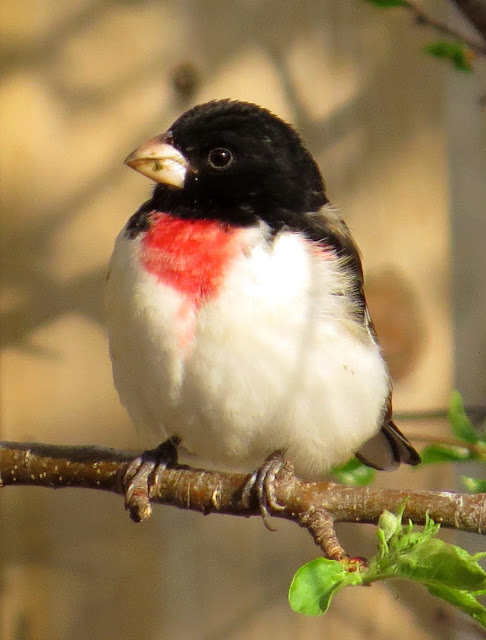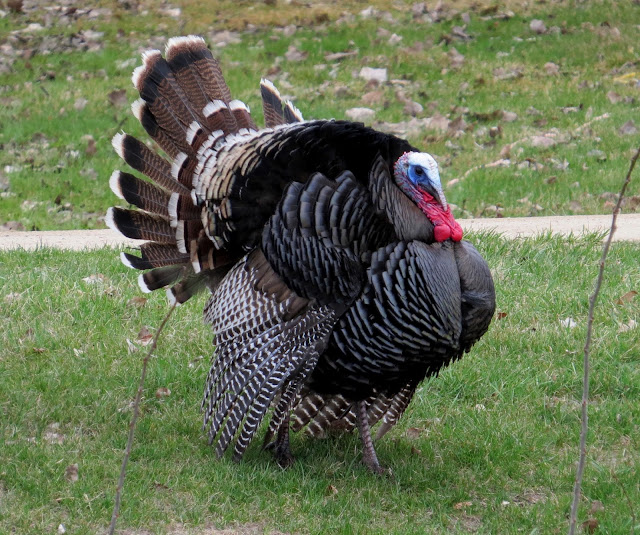Looks like some new Cooper's Hawks (Accipiter cooperii) will be appearing in the not-too-distant future.
This is likely a female COHA Jared Clarke and Kristin Marten banded a few years ago (with Larry Preddy & I helping a teensy bit). A pair returns to this particular nest every couple of years.
Here is a photo of a different COHA after banding.
Beautiful birds.
I haven't posted an Astronomy Photo of the Day (APOD) for a long time.
There are two sky phenomena that intrigue me greatly: the auroras and lightning.
Today's APOD shows a very uncommon set of events...Northern Lights as far south as South Dakota, a clash of storm systems, and the creation of a Red Sprite...caught on camera.

APOD Explanation:
What's that in the sky?
It is a rarely seen form of lightning confirmed only about 25 years ago: a
red sprite.
Recent research has shown that following a powerful positive
cloud-to-ground lightning strike,
red sprites may start as 100-meter balls of
ionized
air that shoot down from about
80-km high at 10 percent the speed of light and are
quickly followed
by a group of upward streaking ionized balls.
The above image, taken a few days ago above central
South Dakota,
USA,
captured a bright red sprite, and is a candidate for the first color
image ever recorded of a sprite and aurora together.
Distant storm clouds cross the bottom of the image,
while streaks of
colorful aurora are visible in the background.
Red sprites take only a fraction of a second to occur and are best seen when
powerful thunderstorms are visible from the side.
http://apod.nasa.gov/apod/
I've had my hummingbird feeders up for about a week in anticipation of a cold, tired, hungry little bird-soul showing up.
And one did this morning. My first-of-year Ruby-throated Hummingbird (Archilochus colubris)
He had his feathers all puffed up. It is a chilly +8C/~47F
I hope this is the first of many. I don't get a lot of hummers, but usually have at least one nesting somewhere in the neighbourhood trees.
Gardening, bird-watching and a bit of photography.....that's about all I'm doing these lovely Spring days.
As of Thursday, my yard was busy with birds: Rose-breasted Grosbeaks, American Goldfinches, House Finches, Pine Siskins, Harris's Sparrows, Red-winged Blackbirds and Baltimore Orioles, to list a few.
A male Red-winged Blackbird (Agelaius phoeniceus) doing a display of dominance or territory or something - I love watching blackbirds, by the way.
And their Icterid cousins, the beautiful Baltimore Orioles (Icterus galbula)
A female oriole
Another handsome male.
A female Tennessee Warbler (Vermivora peregrina) sipping on the flowering plum. I'm glad she likes them; the plum flowers have a beautiful scent.
A wonderful male Rose-breasted Grosbeak (Pheucticus ludovicianus). There is something very calming about Rose-breasted Grosbeaks. This fellow pretty much sat in the same tree all one day. The next day, several more males and a few females arrived and things did get a little more active. However, they don't bicker and squabble like the blackbirds and orioles. Each movement is very studied and slow.
An American Goldfinch (Carduelis tristis) taking a little exception to the arrival of a House Finch (Carpodacus mexicanus). Peace prevailed, with each moving a trifle farther apart.
 Can't wait to see what will be around tomorrow!
Can't wait to see what will be around tomorrow!
Early this past Friday morning, on a quiet road in SW Manitoba, I watched this spectacular Wild Turkey (Meleagris gallopavo) tom strut his stuff for a couple of his lady friends.
Although a native species to Mexico, which is part of North America as far as geography goes, to the birding community this is an introduced/reintroduced species (as is the Gray Partridge, Chukar and Ring-necked Pheasant). Depending on the given birder, the Wild Turkey may or may not be deemed worthy of a check-list tick. I'm not a stickler. My list criteria is that the birds are now a living and breeding population in the wild.
We have a few Wild Turkeys in my area, usually along the Souris River valley. The floods of 2011 took quite a toll on those small populations, so I don't see them often at all.
And if I do find a male displaying in the Spring, the camera comes out
Pete Dunne calls it The Great American Forest Fowl. It is true, they forage on the forest floor, raking through the leaf litter looking for nuts, fruits, berries, seeds, tubers...depending on the season and what's around.
Cool Facts from All About Birds:
- The Wild Turkey and the Muscovy Duck are the only two domesticated birds native to the New World.
- In
the early 1500s, European explorers brought home and domesticated Wild
Turkeys from Mexico. They quickly became popular on European menus
thanks to their large size and rich taste from their diet of wild nuts.
Later, when English colonists settled on the Atlantic Coast, they
brought domesticated turkeys with them.
- The English name of the bird may be a holdover from early shipping
routes that passed through the country of Turkey on their way to
delivering the birds to European markets.
- When they need to, Turkeys can swim by tucking their wings in close, spreading their tails, and kicking.

- As Wild Turkey numbers dwindled through the early twentieth century,
people began to look for ways to reintroduce this valuable game bird.
Initially they tried releasing farm turkeys into the wild but those
birds didn’t survive. In the 1940s, people began catching wild birds and
transporting them to other areas. Such transplantations allowed Wild
Turkeys to spread to all of the lower 48 states (plus Hawaii) and parts
of southern Canada. (Note: the subspecies found out here in the West has white tips to the tail and back feathers, like the original Mexican subspecies, while the eastern birds are all dark. )
- Because of their large size, compact bones,
and long-standing popularity as a dinner item, turkeys have a better
known fossil record than most other birds. Turkey fossils have been
unearthed across the southern United States and Mexico, some of them
dating from more than 5 million years ago.
All right, I guess we didn't need to see that!
All About Birds continues:
Wild Turkeys get around mostly by walking, though they can also run and
fly—when threatened, females tend to fly while males tend to run.
At
sundown turkeys fly into the lower limbs of trees and move upward from
limb to limb to a high roost spot. They usually roost in flocks, but
sometimes individually.
Courting males gobble to attract females and
warn competing males. They display for females by strutting with their
tails fanned, wings lowered, while making nonvocal hums and chump
sounds.
Males breed with multiple mates and form all-male flocks
outside of the breeding season, leaving the chick-rearing to the
females, The chicks travel in a family group with their mother, often
combining with other family groups to form large flocks of young turkeys
accompanied by two or more adult females.
Each sex has an independent
pecking order, with a stable female hierarchy and a constantly changing
male hierarchy.
Wild Turkeys are hunted by coyotes, bobcats, raccoons,
mountain lions, Golden Eagles, Great Horned Owls, and people. Nest
predators include raccoons, opossums, striped skunks, gray foxes,
woodchucks, rat snakes, bull snakes, birds, and rodents
Information sources:
All About Birds/Wild Turkey
















